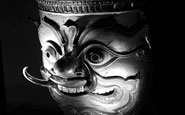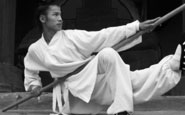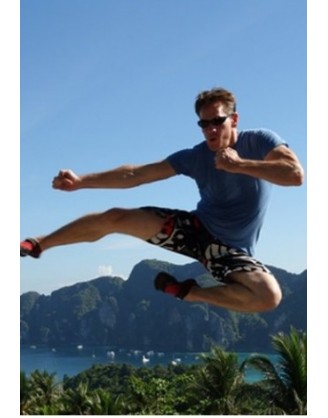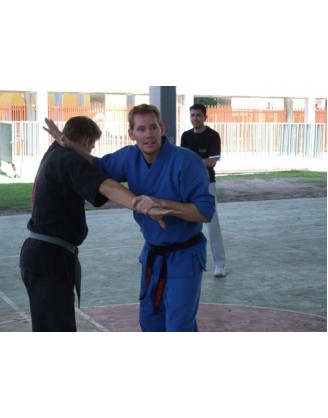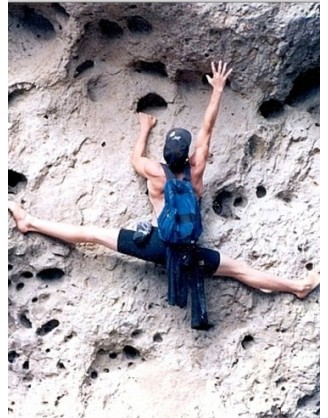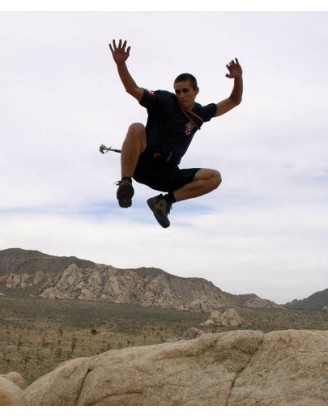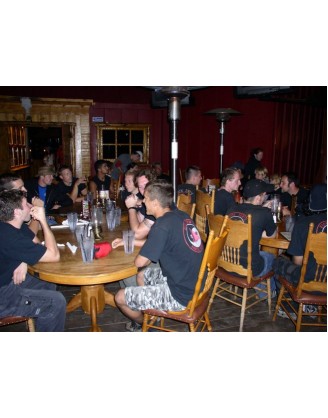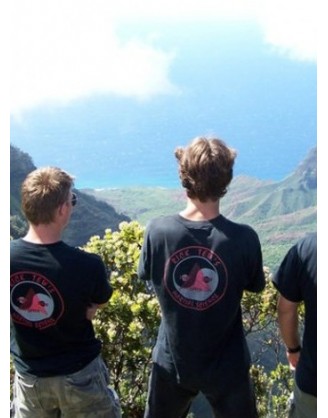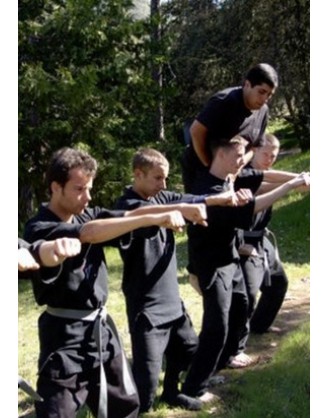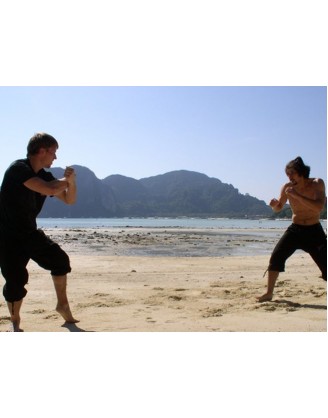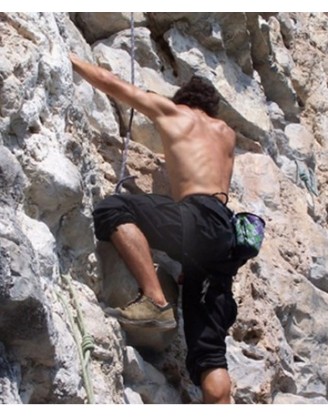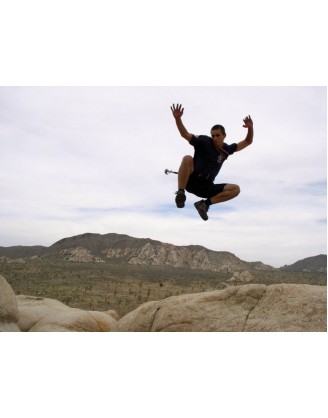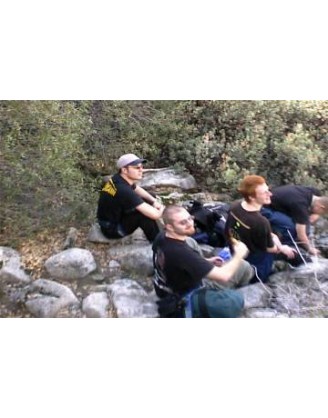Ninja

Ninjutsu
Ninjutsu is the Japanese martial art of espionage, called in English the “techniques of stealth” or the “arts of invisibility.” Practitioners were trained to sneak into enemy territory to learn and report on troops, arms, provisions, and fortifications. The techniques developed further to include active attempts to alter the course of battles, such as arson, assassination, intercepting and/or destroying arms and supplies, and the like. Practitioners were commonly known as ninja, but there were numerous alternative terms: shinobi (spy), onmitsu (secret agent), rappa (wild wave), suppa (transparent wave), toppa (attacking wave), kasa (grass), monomi (seer of things), and nokizaru (monkey under the eaves). Although earlier Japanese chronicles suggest ninjalike activities, ninjutsu developed primarily during the Sengoku period (late fifteenth to sixteenth centuries) when warfare was endemic. Ninjutsu became organized into schools (ryuha) and its techniques systematized. According to Fujita Seiko, there were seventy-one different ryuha, but the three most well known were the Iga-ryu, Koga-ryu, and Kishu-ryu, others being derivative of these.
In Tokugawa times (1600-1867), during two centuries of peace, ninjutsu lost most of its practical value, although some ninja were employed by the Tokugawa bakufu for surveillance and police purposes. The practice of ninjutsu was transformed into one form of martial arts. Due to the secrecy associated with their activities, ninja were often perceived as mysterious and elusive. During the Tokugawa period, after they had virtually passed from the scene, ninja were being portrayed as supermen in drama, art, and literature. Their reputed ability to disappear at will, or leap over walls, or sneak undetected into a castle captured the imagination of people. That image remains strong today. Ninja were already popular in the era before World War II, in fiction and in the films of such directors as Makino Shozo. Then, during the 1960s, the Daiei Series of Shinobi no mono (Ninja; Band of Assassins) films, starring Ichikawa Raizo, ignited a ninja boom that spread widely overseas as part of a larger international fascination with martial arts. Consequently, ninjutsu has been incorporated widely into action novels and films set in locations worldwide and has even lost its Japanese character, as American kids and even cartoon character turtles have been cast as ninja. The ninja has become a thoroughly romanticized and orientalized figure in contemporary global culture.
Ninjutsu ryuha texts maintain legends about its origins, but scholars consider them to be highly inaccurate. It seems probable that techniques of spying and scouting, gathering information for purposes of waging war, were introduced in the seventh and eighth centuries—most likely in organized form through the Chinese military classic by Sunzi (ca. 300-237 B.C.), The Art of War. Prince Shotoku is said to have been the first to employ someone as a shinobi in the defeat of the Mononobe in 587. Others suggest that yamabushi (mountain ascetics) who were practitioners of shugendo—a syncretic form of Shinto-Buddhist belief focusing on the worship of mountains—may be the progenitors of later ninjutsu. In general, early accounts of ninja activities are unsubstantiated.
As the scale of battles increased and war bands became better organized in medieval times, the need for spies and unconventional tactics became critical. In the early fourteenth century, for example, Kusunoki Masashige is said to have relied on ninjalike activities. He reputedly employed Iga ninja to steal into Kyoto to discern the military situation. Moreover, in defense of his fortress, Masashige placed lifelike dolls on the battlements to make his troops appear more numerous. His skills in guerilla warfare led later schools of ninjutsu to claim connection with Masashige.
After the Onin War (1467-1477) and the spread of warfare throughout Japan, various daimyo (regional warlords) began to employ ninja as spies on a regular basis to assist them in expanding their domains. Although ninjutsu ultimately spread from the capital region to central and eastern Japan, local village samurai families in Iga and Koga (plains areas surrounded by mountains on the border of Iga and Omi provinces) primarily developed the techniques. By the late fifteenth century there were reputedly fifty-three Koga and two Iga ninja houses, the leading families being the Hattori and two of that house’s offshoots, the Fujibayashi and Momochi.
Among the daimyo who employed ninja for their skills in espionage were Takeda Shingen, Uesugi Kenshin, and Hojo Ujiyasu. In the Battle of Magari in Omi province in 1487, Rokaku Takayori sent ninja into the camp of the besieging Ashikaga bakufu army, where they set fire to the headquarters and forced the withdrawal of Ashikaga troops. It was through such deeds that the reputation of ninja spread among the daimyo. A nineteenth-century Japanese woodcut depicting a samurai initiated in ninjutsu, the martial art of invisibility, Ninja Museum, Ueno, Japan. The initiates are also known as ninja. (Werner Forman/Art Resource, NY)
of Japan. With the destruction of the Iga and Koga territories by Oda Nobunaga in 1581, many of the local warriors fled to daimyo in eastern Japan, thus further spreading the knowledge of ninjutsu.
The daimyo most closely connected with the use of ninja was Toku-gawa Ieyasu, first shogun of the Tokugawa bakufu established in 1603. The connection dated back two generations, to the time when his grandfather, Matsudaira Kiyoyasu, employed several hundred Iga ninja under Hat-tori Hanzo Yasunaga. When Akechi Mitsuhide's troops assassinated Oda Nobunaga in Kyoto in 1582, Ieyasu avoided attack himself and escaped from Sakai back to his home territory of Mikawa with the assistance of Hattori Hanzo Masanari and a group of ninja. When he became shogun, Ieyasu called Hanzo to Edo, and employed him to lead Iga and Koga ninja to spy on potential enemies of the bakufu. Ninja assisted the Tokugawa at the major engagements of Sekigahara, the sieges of Osaka Castle, and the Shimabara Rebellion. Later, Iga and Koga ninja were incorporated formally into police and surveillance organizations of the regime. Information about ninjutsu can be gleaned from a number of extant scrolls and other texts from the Tokugawa period. Fujita Seiko identified thirty-one texts transmitting ninjutsu teachings. One of the first was the Ninpiden (Legends of Ninja Secrets), a collection of documents and techniques compiled by Hattori Kiyonobu in 1655. The most important extant text is the Bansen shtikai (Ten Thousand Rivers Flow into the Sea) of Fujibayashi Ya-sutake, who completed it in 1675, after twelve years of work. Another important text is the Shoninki (Record of True Ninjutsu) of Fujibayashi Masatake (1681).
Ninjutsu texts appeared somewhat later than those describing the techniques of other martial arts, breaking with a past tradition of secret oral transmission from master to disciple. Martial arts ryuha sprang up throughout Japan, heads of houses possessing knowledge became professional instructors, and samurai were attracted to various schools to learn martial arts as part of the bakufu’s emphasis upon the cultivation of Con-fucian culture, which stresses a balance between martial and civil arts. Scrolls recounting the history of the school, with appropriate connection with various gods and historical figures, and presenting the techniques of the tradition, became an important part of the teaching and ritual components of the various schools, including ninjutsu.
Techniques and Weapons
Since ninja were first and foremost spies, completing one’s missions and returning to report were of the essence. Ninjutsu can thus be seen as the art of escape, and techniques were designed to ensure survival. “In ninjutsu there are both overt and covert techniques. The former refer to techniques utilized when one does not disguise his appearance and uses strategy and ingenuity to penetrate enemy territory, while the latter refers to stealing into the enemy camp using techniques of concealment, so as not to be seen by others” (Bansen shukai 1982, 481). Ninja were taught how to disguise themselves to pass unnoticed and were trained in multiple forms of fleeing, based on knowledge of animal behavior. Night provided an excellent cover for ninja actions. For night work, ninja wore black clothing and a hood to avoid detection; but in the daylight, they normally wore brown clothing with reversible gray on the inside, which blended in with natural surroundings. Naturally, they were often in disguise, as an itinerant priest, a merchant, or the like.
Ninjutsu taught familiarity with natural elements as a means of concealing one’s presence: using the shade of trees or rocks to hide; carrying out operations at night; employing the confusion created by storms, fog, or fires to sneak into a castle or house. Festivals, brawls, and other occasions where crowds gathered could be utilized for similar purposes.
Ninja might pass a guard post by posing as comrades, calling out false commands, or shouting “Fire.” Familiarity with the details of the enemy territory, including knowledge of the local dialect, was also considered invaluable. Naturally, not all contingencies could be covered, so above all, ninja were expected to be inventive and not be limited by their training. “Since secret techniques for necessary penetration (of the enemy’s camp) are but temporary and expedient forms of deception, you need not always follow old ninja techniques. Neither need you discard them” (Bansen shukai 1982, 481)
Ninja developed a bewildering variety of tools to assist them in accomplishing their missions, including the “six utensils” normally carried by ninja: sedge hat, rope, slate pencil, medicine, tenugui (a form of small towel), and tsuketake (for lighting fires). For longer missions, a ninja would carry drink and dried food. For certain tasks, there were specialized tools of various kinds, divided in the Bansen shukai into climbing tools, water utensils (various means of crossing ponds and moats, or hiding in them), opening tools for entering residences, and fire and explosive devices—smoke bombs, fire arrows, and gunpowder for rifles and cannon. The Bansen shukai warns ninja not to be overloaded with equipment, but to discern what is necessary for the mission and take only those tools. “Thus a successful ninja is one who uses but one tool for multiple tasks” (Bansen shukai 1982, 535).
In order to carry out missions of spying, assassination, and ambush, and even in order to fight in regular battle or defend himself against attack, the ninja had to be well trained in martial skills and at the height of physical and mental discipline. This required mastery of most of the major weapons systems and martial skills of the day: sword, lance, bow and arrow (ninja, however, used short bows), grappling, staff, gunnery, and horsemanship. There were other weapons more likely to be employed by ninja than by other warriors, such as throwing missiles (shuriken), which ranged from simple short knives to three-, four-, six- or even eight-pointed “stars.” Ninja practiced swimming, running to cover long distances with- out fatigue, breath control, and various ways of walking to avoid sound and, thus, detection. They also had to be skilled at climbing, employing various tools to assist them, such as rope ladders and metal claws that attached to the hands. Working often at night, they trained to increase their ability to see in the dark and hear especially well.
Ninjutsu scholars note forms of chanting, magic spells, incantations, and mudras (hand gestures) in order to focus one’s mental power and receive divine protection. These techniques presumably derived from similar esoteric Buddhist practices of yamabushi (mountain warriors), shugendo practitioners whose purpose was to attain Buddhahood through such ascetic discipline. Though secondary sources often stress these magical aspects of ninjutsu, major texts are silent regarding them.
Yet clearly, severe spiritual training was necessary to accomplish difficult missions. Thus, the first two sections of Bansen shtikai stress spiritual or mental preparation. “A correct mind [seishin] is the source of all things and all actions. Now, since ninjutsu involves using ingenuity and stratagems to climb over fences and walls, or to use [various ninja tools] to break in, it is quite like the techniques of thieves. If someone not revering the Way of Heaven should acquire [ninjutsu] skills and carry out evil acts, then my writing this book would be tantamount to revealing the techniques of robbery. Thus I place greatest importance on a correct mind”.
Yasutake devotes two sections to developing a correct mind. Rather than providing prescriptions for spiritual training such as techniques of meditation or the use of mudras, he instead quotes from classical Chinese texts espousing that the ninja practice Confucian virtues of loyalty, benevolence, justice, and truth. Yasutake considers the most essential ingredient of the correct mind for a ninja to be the ability to rise above concerns for life and death, which he notes is as hard for a man to comprehend as it is for a bird to speak. He explains the workings of the universe in terms of the interaction of yin and yang and the five elements, in order for students to understand that life and death are intimately related and thus death is natural: “Life is man’s yang, and death is his yin,” as he puts it (Bansen sbukai ).
The practice of ninjutsu has been revived since World War II and taught openly in several places in Japan. It has also been exported abroad, with the result that there are centers of training in so-called ninjutsu in many places throughout the world. Several years ago, on a Japanese What’s My Line, a young American stumped the panel, who could not discern that his occupation was ninja. As the martial arts have become internationalized, cross-fertilization has taken place, with the result that schools teaching ninjutsu often incorporate standard techniques from karate, kung fu, and other martial arts into their repertoire. Ninjutsu continues to fascinate audiences worldwide, and modern warfare still allows considerable room for employment of commando forces, so the fascination with mastery of ninja skills of espionage provides a welcome marketing device for teachers. Yet there are no ninja today, only practitioners of some of the techniques and students of the tradition. Achievement of some rank within a school teaching ninjutsu cannot make one a ninja, any more than learning techniques with the sword can qualify one as a samurai.


